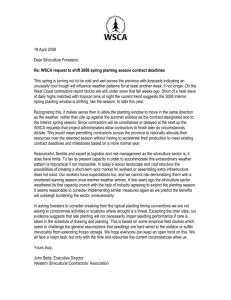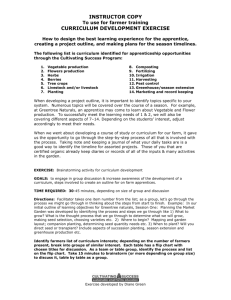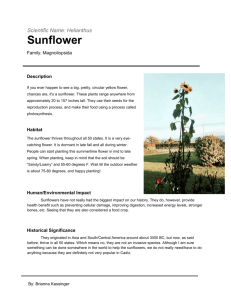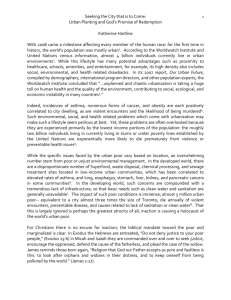P D F s
advertisement
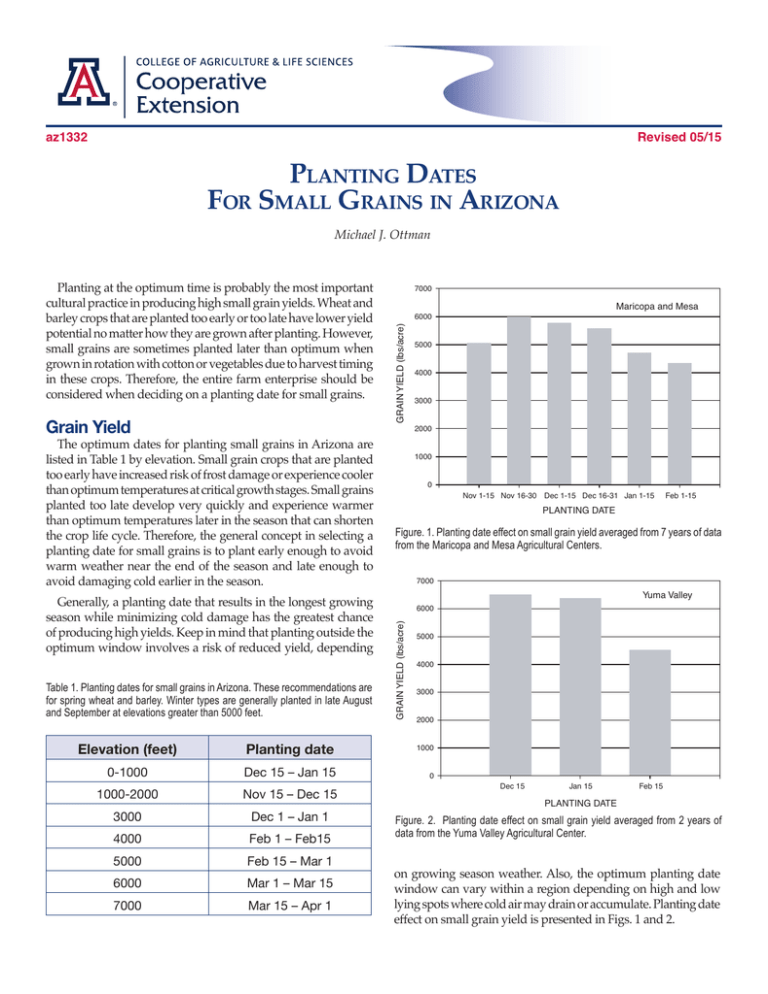
az1332 Revised 05/15 Planting Dates For Small Grains in Arizona Michael J. Ottman The optimum dates for planting small grains in Arizona are listed in Table 1 by elevation. Small grain crops that are planted too early have increased risk of frost damage or experience cooler than optimum temperatures at critical growth stages. Small grains planted too late develop very quickly and experience warmer than optimum temperatures later in the season that can shorten the crop life cycle. Therefore, the general concept in selecting a planting date for small grains is to plant early enough to avoid warm weather near the end of the season and late enough to avoid damaging cold earlier in the season. Generally, a planting date that results in the longest growing season while minimizing cold damage has the greatest chance of producing high yields. Keep in mind that planting outside the optimum window involves a risk of reduced yield, depending Table 1. Planting dates for small grains in Arizona. These recommendations are for spring wheat and barley. Winter types are generally planted in late August and September at elevations greater than 5000 feet. Maricopa and Mesa 6000 GRAIN YIELD (lbs/acre) Grain Yield 7000 5000 4000 3000 2000 1000 0 Nov 1-15 Nov 16-30 Dec 1-15 Dec 16-31 Jan 1-15 Feb 1-15 PLANTING DATE Figure. 1. Planting date effect on small grain yield averaged from 7 years of data from the Maricopa and Mesa Agricultural Centers. 7000 Yuma Valley 6000 GRAIN YIELD (lbs/acre) Planting at the optimum time is probably the most important cultural practice in producing high small grain yields. Wheat and barley crops that are planted too early or too late have lower yield potential no matter how they are grown after planting. However, small grains are sometimes planted later than optimum when grown in rotation with cotton or vegetables due to harvest timing in these crops. Therefore, the entire farm enterprise should be considered when deciding on a planting date for small grains. 5000 4000 3000 2000 Elevation (feet) Planting date 1000 0-1000 Dec 15 – Jan 15 0 1000-2000 Nov 15 – Dec 15 3000 Dec 1 – Jan 1 4000 Feb 1 – Feb15 5000 Feb 15 – Mar 1 6000 Mar 1 – Mar 15 7000 Mar 15 – Apr 1 Dec 15 Jan 15 Feb 15 PLANTING DATE Figure. 2. Planting date effect on small grain yield averaged from 2 years of data from the Yuma Valley Agricultural Center. on growing season weather. Also, the optimum planting date window can vary within a region depending on high and low lying spots where cold air may drain or accumulate. Planting date effect on small grain yield is presented in Figs. 1 and 2. Crop Variety A strategy to avoid either cold damage early in the season or higher than optimum temperatures later in the season is to select full season varieties when planting early and short season varieties when planting late. In barley, there is about a 19 day difference in heading dates between short and full season varieties. In durum, only about a 5 day difference in heading date exists among varieties currently produced in Arizona. Crop Development Planting dates affect both plant appearance and the length of time required to reach heading and maturity. Early planting dates usually result in crops that have more vegetative growth, more tillers, more leaves, wider leaves, taller plants, and increased risk of lodging compared to late planting dates. Durum planted in December at Maricopa will have about 9 to 10 leaves on the main stem. The leaf number will increase by one if planted in November or decrease by one if planted in January. Generally, a one month difference in planting date results in only 5 to 6 days difference in harvest date due to heat units and photoperiod sensitivity (Table 2). Small grain development is driven primarily by heat unit accumulation, and more heat units are accumulated near harvest than planting resulting in fewer days between harvest dates compared to planting dates. Small grain development is also affected by photoperiod, so flowering is delayed in earlier plantings until a certain daylength is achieved in spring. It is during this time that an extra leaf may develop on the main stem before head emergence. Most varieties grown in Arizona have a similar photoperiod response, except for certain short season barley varieties that exhibit only a minor response to photoperiod. Risk of Frost Damage Planting small grain crops too early increases the probability of frost damage (Table 2). Temperatures below 30° F are usually required to cause damage (Table 3). The pollen is the most susceptible plant part to cold damage followed by other floral parts. The leaves and stems can withstand temperatures down to 14° to 19° F. Even if the entire above-ground portion of the plant is destroyed by cold, regrowth can occur from the crown if the growing point is not damaged. Leaf tips can be damaged by cold, but yield usually is not affected by this type of injury. Cold injury to the developing floral parts in the head is the greatest concern due to its impact on yield. The head is somewhat protected against cold injury until the boot stage. The head is susceptible to cold injury after boot and particularly during pollen shed. Since pollen is shed over a period of 4-7 days, several consecutive nights of cold temperatures are necessary to cause 100% damage. Frost injury may not be readily evident during the grain ripening process and may only become apparent at harvest. If only the pollen is damaged, the heads may look normal, but the grain may not fill. If parts of the head other than the pollen are damaged, the head may turn a light tan color in about a week . Development of kernels only in the middle of the head or only at the base and tip is diagnostic for frost damage, since flowering occurs first in the middle of the head and then spreads to the base and tip. The developing kernels can be checked about one week after pollination to verify if frost damage occurred. At this time, the kernel should be about one-half of its final length and have a watery consistency. A damaged kernel will be shriveled, and if the pollen was killed, no kernel will be present. Table 2. Heading, maturity, and frost risk for various planting dates at Maricopa for durum. Planting Heading Physiological Maturity Frost damageprobability (%) Nov 1 Mar 6 Apr 27 38 Nov 15 Mar 16 May 2 22 Dec 1 Mar 24 May 6 13 Dec 15 Mar 30 May 8 8 Jan 1 Apr 4 May 11 2 Jan 15 Apr 9 May 13 0 Table 3. Critical temperatures for freeze injury to wheat at various growth stages*. Growth stage Approximate injurious temperature (two hours) Tillering 14 - 19°F Slight to moderate Jointing 24° F Moderate to severe Boot 28° F Moderate to severe Heading 30° F Severe Flowering 30° F Severe Milk 28° F Moderate to severe Dough 28° F Slight to moderate Relative yield effect * Adapted from: Shroyer, J. P., M. E. Mikesell, and G. M. Paulsen. 1995. Spring freeze injury to Kansas Wheat. Ag. Exp. Stn. and Coop. Ext. Serv, Kansas State Univ., Manhattan. 2 The University of Arizona Cooperative Extension COLLEGE OF AGRICULTURE & LIFE SCIENCES Cooperative Extension The University of Arizona College of Agriculture and Life Sciences Tucson, Arizona 85721 Michael J. Ottman Agronomy Specialist Contact: Michael J. Ottman mottman@cals.arizona.edu This information has been reviewed by University faculty. extension.arizona.edu/pubs/az1332-2015.pdf Originally published: 2004 Other titles from Arizona Cooperative Extension can be found at: extension.arizona.edu/pubs Any products, services or organizations that are mentioned, shown or indirectly implied in this publication do not imply endorsement by The University of Arizona. Issued in furtherance of Cooperative Extension work, acts of May 8 and June 30, 1914, in cooperation with the U.S. Department of Agriculture, Jeffrey C. Silvertooth, Associate Dean & Director, Extension & Economic Development, College of Agriculture Life Sciences, The University of Arizona. The University of Arizona is an equal opportunity, affirmative action institution. The University does not discriminate on the basis of race, color, religion, sex, national origin, age, disability, veteran status, or sexual orientation in its programs and activities. The University of Arizona Cooperative Extension 3

